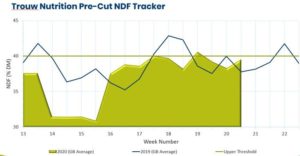Over the last week, grass growth continued to increase, with the East and South West both seeing figures over 70kg DM/ha/day. Scotland and Yorkshire had the lowest growth rates of 55kg DM/ha/day. The region which saw the greatest increase in growth was the South East of 16kg DM/ha/day bringing growth rates to 67kg DM/ha/day.
Potential MYFG averaged at M+10.8 litres/day. This figure is a drop on the previous week’s average and is below the 2019 and the 6-year average for the same week. The reduction in MYFG can be a result of the reduction in potential grass DM intake, from 12.58kg/day to 11.01kg/day. The highest MYFG was seen in Wales and the West at M+13.6litres/day, while the lowest of M+5.4litres/day was seen in the East. It is important to note that a relatively small sample was received from the East.
Rapidly Fermentable Carbohydrates (RFC) and Acid Load levels have increased, highlighting that consideration should be given to strategies that work to control rumen pH; reducing the fermentability in the diet and the inclusion of rumen buffers and yeasts.
The risk of grass staggers continues to soar, risk factors to susceptibility include:
• Post calving and peak lactation (due to high Mg output in colostrum and milk)
• Grass containing high levels of potassium
• Older cows.
The requirement of the rumen microbes to adapt to new diets and with large dietary changes during the time of year brings a heightened risk (not only to grass stagers) to acidosis. To provide an antacid effect add rumen buffers to the diets, and to stimulate growth of favourable microbial populations include a yeast, both to help limit the risk of acidosis.
Pre-Cut NDF Tracker
High numbers of sample submissions were received during the latest period (n=450). The average NDF content of these samples are again within the optimum threshold of 38-40%, at 39.58%. This highlights that opportunities remain for cutting. 27% of samples were received from Wales and West and 27% from Scotland. 17% of samples were received from the North West and just over 7% from the North East and Yorkshire with 1% from the East. *Please remember to ensure samples are labelled correctly with regional information
